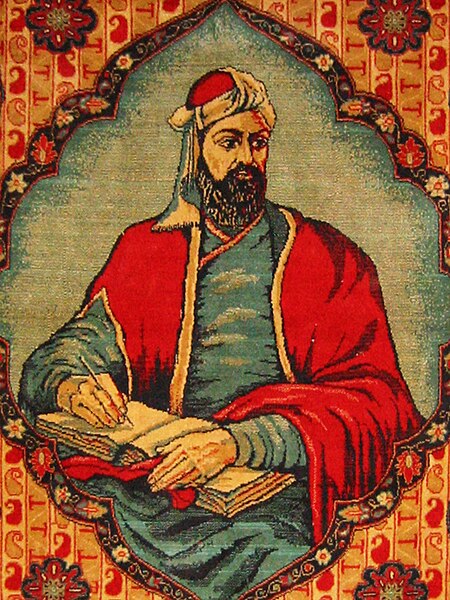Khamsa of Nizami (British Library, Or. 12208)
The illuminated manuscript Khamsa of Nizami British Library, Or. 12208 is a lavishly illustrated manuscript of the Khamsa or "five poems" of Nizami Ganjavi, a 12th-century Persian poet, which was created for the Mughal Emperor Akbar in the early 1590s by a number of artists and a single scribe working at the Mughal court, very probably in Akbar's new capital of Lahore in North India, now in Pakistan. Apart from the fine calligraphy of the Persian text, the manuscript is celebrated for over forty Mughal miniatures of the highest quality throughout the text; five of these are detached from the main manuscript and are in the Walters Art Museum, Baltimore as Walters Art Museum MS W.613. The manuscript has been described as "one of the finest examples of the Indo-Muslim arts of the book", and "one of the most perfect of the de luxe type of manuscripts made for Akbar".
Detail of the added miniature by Daulat showing him (left) painting the calligrapher of the manuscript, Abd al-Rahim
Farhad Before Khusraw, one of the Walters' pages
The Death of Darius, by Dharm Das, another Walters page
Bim Gujarati, Alexander the Great Enthroned at Persepolis
Nizami Ganjavi, Nizami Ganje'i, Nizami, or Nezāmi, whose formal name was Jamal ad-Dīn Abū Muḥammad Ilyās ibn-Yūsuf ibn-Zakkī, was a 12th-century Muslim poet. Nizami is considered the greatest romantic epic poet in Persian literature, who brought a colloquial and realistic style to the Persian epic. His heritage is widely appreciated in Afghanistan, Republic of Azerbaijan, Iran, the Kurdistan region and Tajikistan.
Rug depiction of Nizami Ganjavi (1939). Ganja Museum, Republic of Azerbaijan.
Nizami Ganjavi at shah's reception. Miniature. 1570. Museum of History of Azerbaijan
Khosrow Parviz discovers Shirin bathing in a pool. Nezami's poems in a Persian miniature, created in ca. 1550 in Shiraz, Persia. Collection of Freer Gallery of Art
Atabeg of Azerbaijan Qizil Arslan welcomes Nizami








